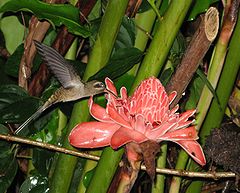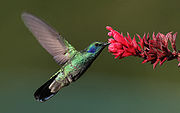
Ornithophily
Encyclopedia

Pollination
Pollination is the process by which pollen is transferred in plants, thereby enabling fertilisation and sexual reproduction. Pollen grains transport the male gametes to where the female gamete are contained within the carpel; in gymnosperms the pollen is directly applied to the ovule itself...
of flowering plants by bird
Bird
Birds are feathered, winged, bipedal, endothermic , egg-laying, vertebrate animals. Around 10,000 living species and 188 families makes them the most speciose class of tetrapod vertebrates. They inhabit ecosystems across the globe, from the Arctic to the Antarctic. Extant birds range in size from...
s. This coevolutionary association is derived from insect pollination (entomophily
Entomophily
Entomophily is a form of pollination whereby pollen is distributed by insects. Several insect are reported to be responsible for the pollination of many plant species, particularly bees, Lepidoptera , wasps, flies, ants and beetles. Some plant species co-evolved with a particular pollinator, such...
) and is particularly well developed in some parts of the world, especially in the tropics and on some island chains. The association involves several distinctive plant adaptations forming a "pollination syndrome
Pollination syndrome
Pollination syndromes are suites of flower traits that have evolved in response to natural selection imposed by different pollen vectors, which can be abiotic or biotic, such as birds, bees, flies, and so forth. These traits include flower shape, size, colour, odour, reward type and amount, nectar...
". The plants typically have colourful, often red, flowers with long tubular structures holding ample nectar and orientations of the stamen and stigma that ensure contact with the pollinator. Birds involved in ornithophily tend to be specialist nectarivore
Nectarivore
In zoology, nectarivore is an animal which eats the sugar-rich nectar produced by flowering plants. Most nectarivores are insects or birds, but there are also nectarivorous mammals, notably several species of bats in the Southwestern United States and Mexico, as well as the Australian Honey Possum...
s with brushy tongues, long beaks, capable of hovering flight or are light enough to perch on the flower structures.
Plant adaptations

Plants adaptations may be grouped into mechanisms that attract birds, those that exclude insects, protect against nectar theft and pollination mechanisms in the strict sense. The ovules of bird flowers also tend to have adaptations that protect them from damage.
Most bird pollinated flowers are red and have a lot of nectar. They also tend to be unscented. Flowers with generalist pollinators tend to have dilute nectar but those that have specialist pollinators such as hummingbirds or sunbirds tend to have more concentrated nectar. The nectar of ornithophilous flowers vary in the sugar composition, with hexoses being high in passerine pollinated species while those that are insect pollinated tend to be sucrose rich. Hummingbird pollinated flowers however tend to be sucrose rich. Many plants of the family Loranthaceae
Loranthaceae
Loranthaceae is a family of flowering plants, which has been universally recognized by taxonomists. It consists of about 75 genera and 1,000 species of woody plants, many of them hemi-parasites, all of them except three having the mistletoe habit...
have explosive flowers that shower pollen on a bird that forages near it. They are associated mainly with flowerpeckers in the Dicaeidae family. In Australia, some species of Banksia
Banksia
Banksia is a genus of around 170 species in the plant family Proteaceae. These Australian wildflowers and popular garden plants are easily recognised by their characteristic flower spikes and fruiting "cones" and heads. When it comes to size, banksias range from prostrate woody shrubs to trees up...
have flowers that open in response to bird actions thereby reducing the wastage of pollen. As many as 129 species of North American plants have evolved ornithophilous associations. Nearly a fourth of the 900 species of the genus Salvia are bird pollinated in the South African region. Tropical China and the adjacent Indochinese countries harbor relatively few bird-pollinated flowers, among them the Hamamelidaceae Rhodoleia championii, which at any one site can be visited and pollinated by up to seven species of nectar-foraging birds, including Japanese white-eyes (Zosterops japonicus, Zosteropidae) and fork-tailed sunbirds (Aethopyga christinae, Nectariniidae).
The rat's tail babiana (Babiana ringens Ker Gawl.) is a species of plant that produces a strong stalk within the inflorescence that serves as a perch for the Malachite Sunbird
Malachite Sunbird
The Malachite Sunbird, Nectarinia famosa is a small nectivorous bird found in the southern part of the Southern African region.- Taxonomy :...
as it visits the flower. Heliconia
Heliconia
Heliconia, derived from the Greek word helikonios, is a genus of about 100 to 200 species of flowering plants native to the tropical Americas and the Pacific Ocean islands west to Indonesia. Many species of Heliconia are found in rainforests or tropical wet forests of these regions...
s have special sticky threads that help in the adhesion of pollen to smooth structures such as the bill of a hummingbird. Some African orchids of the genus Disa
Disa (orchid)
The orchid genus Disa consists of 169 terrestrial orchid species in tropical and South Africa, Madagascar and along the Western Indian Ocean...
have pollinaria that stick to the feet of visiting sunbirds.
Plants need to protect against nectar being taken by non-pollinators. These agents are classified into nectar robbers, which may destroy the flower, for example cut the flower at the base to obtain nectar and nectar thieves that obtain nectar without pollinating the flower.
Bird adaptations
The main families of specialized nectar feeding birds that are involved in ornithophily are the hummingbirds (Trochilidae), sunbirds (Nectariniidae), and the honey-eaters (Meliphagidae). Other important bird groups include those in the families the Icteridae, the honeycreepers (Thraupidae, Drepanidae), white-eyes (Zosteropidae) and the South African sugar-birds (Promeropidae). Birds may obtain nectar either by perching or by hovering with the latter mainly found in the hummingbirds and sunbirds. Within the hummingbirds, two kinds of foraging are noted with territorial "hermit" hummingbirds and the non-hermits which forage longer distancesHummingbirds have the ability to digest sucrose unlike many passerines that prefer hexoses (fructose and glucose). Starlings and their relatives will completely avoid sucrose. Nectar feeding birds typically have a mechanism to quickly excrete excess water. They may have to drink four to five times their body mass of liquid during the day to obtain enough energy. Hummingbirds are capable of excreting nitrogenous wastes as ammonia since they can afford more water loss than birds that feed on low-moisture food sources. Hummingbirds and sunbirds also have special anatomical and physiological adaptations that allow them to quickly excrete excess water. Hummingbirds are also able to turn off their kidney function at night.
In some birds such as white-eyes, the pollen dusted by the plants on the forehead of the birds may increase the wear of these feathers leading to increased moulting and replacement.
Other associations
Several mite species (mainly in the genera ProctolaelapsProctolaelaps
Proctolaelaps is a genus of mites in the family Ascidae.-Species:* Proctolaelaps antennatus Karg, 1985 * Proctolaelaps arctorotundus Nikolsky, 1984 * Proctolaelaps aurora...
, Tropicoseius
Tropicoseius
Tropicoseius is a genus of mites in the family Ascidae.-Species:* Tropicoseius adsimilis * Tropicoseius analis * Tropicoseius bellavistensis...
and Rhinoseius
Rhinoseius
Rhinoseius is a genus of mites in the family Ascidae.-Species:* Rhinoseius androdon Fain & Hyland, 1980 * Rhinoseius antioquiensis Fain & Hyland, 1980 * Rhinoseius bakeri...
, family Ascidae
Ascidae
Ascidae is a family of mites in the order Mesostigmata.-Genera:* Aceoseius Sellnick, 1941 * Adhaerenseius G. C. Loots & P. D. Theron, 1992 * Africoseius Krantz, 1962 * Anephiasca Athias-Henriot, 1969...
) have evolved a phoretic mode of life, climbing into the nostrils of hummingbirds that visit flowers and hitching a ride to other flowers where they can feed on the nectar. Hummingbird flower mites favour plants in the families of Heliconiaceae, Costaceae
Costaceae
Costaceae or the Costus Family is a family of pantropical monocots. They belong to the order Zingiberales, which contains other horticulturally and economically important plants such as the banana , bird-of-paradise , and edible ginger...
, Zingiberaceae
Zingiberaceae
Zingiberaceae, or the Ginger family, is a family of flowering plants consisting of aromatic perennial herbs with creeping horizontal or tuberous rhizomes, comprising ca. 52 genera and more than 1300 species, distributed throughout tropical Africa, Asia, and the Americas.Many species are important...
, Amaryllidaceae
Amaryllidaceae
Amaryllidoideae is the subfamily of flowering plants that takes its name from the genus Amaryllis. It is part of the family Amaryllidaceae, in order Asparagales...
, Rubiaceae
Rubiaceae
The Rubiaceae is a family of flowering plants, variously called the coffee family, madder family, or bedstraw family. The group contains many commonly known plants, including the economically important coffee , quinine , and gambier , and the horticulturally valuable madder , west indian jasmine ,...
, Apocynaceae
Apocynaceae
The Apocynaceae or dogbane family is a family of flowering plants that includes trees, shrubs, herbs, and lianas.Many species are tall trees found in tropical rainforests, and most are from the tropics and subtropics, but some grow in tropical dry, xeric environments. There are also perennial herbs...
, Bromeliaceae
Bromeliaceae
Bromeliaceae is a family of monocot flowering plants of around 3,170 species native mainly to the tropical Americas, with a few species found in the American subtropics and one in tropical west Africa, Pitcairnia feliciana...
, Gesneriaceae
Gesneriaceae
Gesneriaceae is a family of flowering plants consisting of ca. 150 genera and ca. 3,200 species in the Old World and New World tropics and subtropics, with a very small number extending to temperate areas. Many species have colorful and showy flowers and are cultivated as ornamental plants.Most...
, Lobeliaceae
Lobeliaceae
Lobelioideae is a subfamily of the plant family Campanulaceae. It contains 32 genera, totalling about 1200 species. Some of the larger genera are Lobelia, Siphocampylus, Centropogon, Burmeistera and Cyanea....
and Ericaceae
Ericaceae
The Ericaceae, commonly known as the heath or heather family, is a group of mostly calcifuge flowering plants. The family is large, with roughly 4000 species spread across 126 genera, making it the 14th most speciose family of flowering plants...
, members of which are associated with Hummingbirds.

